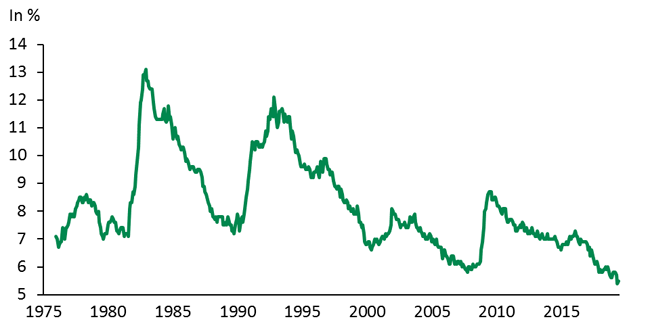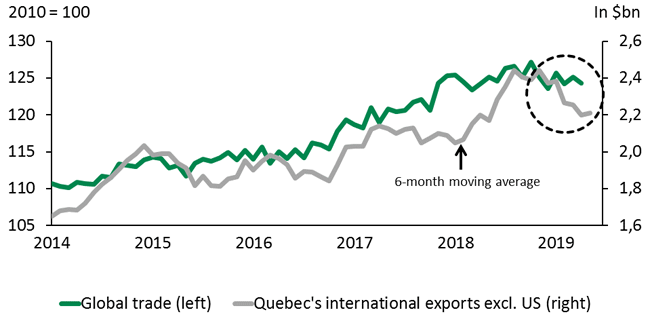Global trade stabilizes but uncertainty lingers
After several months on the decline, global trade is beginning to show signs of stabilization (Graph 1). However, the situation remains sensitive and could deteriorate if new trade-related tensions emerge. In a notable development, manufacturing PMIs in several countries slumped to very low levels.
Graph 1 –Global trade appears to be stabilizing

Sources: CPB – Netherlands Bureau for Economic Policy Analysis and Desjardins Economic Studies
In the United States, real GDP grew at an annualized rate of 3.1% in the first quarter of 2019. While this increase is faster than expected, it masks a number of less favourable developments, including a slowdown in final domestic demand. Real GDP growth was more modest for the spring as a whole, with an increase of 2.1%. Growth is anticipated to be 2.6% for all of 2019 and 2.1% for 2020. However, these outlooks assume that emerging weaknesses in the economy won’t get out of control, and that trade tensions with China, Mexico and Europe don’t deteriorate. Fears of a looming recession have become more pronounced. The current economic cycle reached 120 months at the end of June, matching the duration of the longest cycle ever recorded in US history (in the 1990s).
The US Federal Reserve (the Fed) is expected to cut interest rates twice before the fall of 2019, which would help keep bond yields near current lows. This stance by the Fed primarily aims to respond to market pressure and reaffirm the Fed’s commitment to keeping inflation forecasts near the 2% target. Given that monetary tightening is at a less advanced stage in Canada, it would be surprising if the Bank of Canada followed the Fed’s lead. Given the prevailing environment, we continue to anticipate a long status quo for Canada’s key interest rates. The favourable trend in interest rate spreads could lead to a slightly stronger Canadian dollar in the coming months.
The Canadian economy continued to experience weakness in early 2019. After gaining only 0.3% annualized in the final quarter of 2018, economic growth reached 0.4% during the first three months of 2019. While these results may appear disappointing on the surface, the news is excellent when it comes to domestic demand, which rebounded by 3.4% in the first quarter, ending two consecutive quarters of declines (Graph 2). This data leads us to conclude that Canada’s challenging situation with real GDP growth can be attributed to a major deterioration in the trade balance. Nonetheless, Canada’s economic growth should pick up the pace in the second quarter, while the negative impacts of lower oil production should gradually diminish. Following this, however, real GDP growth could slow down slightly due to the moderate deterioration of global economic conditions. Against this backdrop, Canada’s real GDP growth could reach 1.3% in 2019 and 1.6% in 2020.
Graph 2 –Very low unemployment is boosting domestic demand in Canada

Sources: Statistics Canada and Desjardins Economic Studies
Quebec’s economic growth has significantly outperformed Canada as a whole since mid-2018. The province has a dynamic residential real estate market and it is well sheltered from the problems in the oil sector. However, the slowdown in global trade, aggravated by the large number of tariffs in place between the United States and several countries (particularly China), is gradually weighing down on Quebec’s international exports (Graph 3). After rising over the past several years, Quebec’s foreign exports initially began to stabilize a few months ago, and have more recently begun to decline. Quebec’s exports to Europe have eroded more substantially due to the weakness of the economy, while its Asian exports appear to be on the cusp of a downward trend. Given these conditions, Quebec’s real GDP growth should amount to approximately 2.0% in 2019 and around 1.5% in 2020.
Quebec’s international exports are feeling the effects of the global trade slowdown

Sources: CPB – Netherlands Bureau for Economic Policy Analysis and Desjardins Economic Studies
